The Power of Chocolate
Chocoholics: Is it possible to know enough about chocolate? What do we need to know, except that it tastes wonderful? Worldwatch Institute writer Gaelle Gourmelon discusses chocolate's history and the social and ecological impacts of the way it is grown, and how all of us chocoholics can help to improve matters — even just by choosing what to buy. This article is from the Worldwatch Institute.
Take a bite. Then take a minute to think. Have you ever considered where your chocolate comes from? You might know that it grows on trees (perhaps justifying to yourself that chocolate is a “vegetable”)—and you’d be right. But you may be in the dark about the places and people involved in getting chocolate from the farm to the store.
Here’s a quick primer on what you should know about chocolate and how you, as a chocolate aficionado, can make a positive mark.
Chocolate’s History
Despite humanity’s 4,000-year love affair with chocolate, the sweet treat has never before been consumed at today’s massive scale. In fact, cacao was long reserved exclusively for religious and social elites.
The first evidence of cacao consumption dates to the pre-Olmecs in Central America, around 1900 B.C. Later, the Mayans drank bitter cacao drinks for religious ceremonies, reserving the sacred beverage for the highest echelons of society. When the Aztecs conquered the Mayans, the vanquishers demanded cacao tributes. The Aztecs valued the beans so much that they were used as a form of currency (1 cacao bean could buy you a tomato, 30 beans got you a rabbit, and 200 beans could snag you a turkey).

In the 1500s, Spanish conquistadors were introduced to cacao at banquets. Not everyone was a fan (one conquistador called it “a bitter drink for pigs“). But cacao found its way back to Spain where, once the beverage was sweetened, it gained popularity among the Spanish elite. Royal marriages eventually spread the aristocratic nectar to many of Europe’s wealthiest families.

In the early 1800s, the Industrial Era fundamentally shifted chocolate consumption. Steam-powered factories made it affordable to the masses. Simultaneously, European empires set up chocolate and sugar plantations using cheap colonial labor, bringing down the costs of production. Chocolate became a large-scale operation, and chocolate bars became available to the general public for the first time.
Today, the chocolate candy industry has grown to $100 billion a year. The demand for chocolate is only expected to grow as consumers in China, India, and elsewhere earn more disposable income.
The Origins of Chocolate
Cacao comes from the Theobroma cacao plant, a native of the Amazon basin, and thrives around the Equator. Growing cacao requires patience and lots of hands-on work. When the plants are two to three years old, tiny flowers bloom from the trunk and branches and are pollinated by small insects (chocolate midges) that live in decomposing leaves on the ground.
After six months, the pods ripen. Farmers cut them off, split them open, and manually remove the fruit and beans, leaving them to ferment for 36 to 72 hours in baskets or on banana leaves. During this critical period, yeasts and bacteria feast on the cacao and develop the chocolate’s flavor.
The farmers then slowly dry the beans in the sun for about a week, turning or raking them. Some countries that do not have extended sunny periods use artificial drying, but this often damages the flavor of the bean. Farmers then sort the beans to remove debris and send them off to distributors.
Factories shell, grind, mix, powder, temper, mold, cool, unmold, and pack the bar of chocolate that we know and love. (Despite the wonderfully 1990s flair of chocolate production in this video, the basic steps have remained unchanged.)
Impacts of Chocolate
Most chocolate today is produced in a manner that gives big companies big money but often leaves farmers and their land in a bind.
Perpetuating Poverty
Because few mechanized processes for cacao have been developed, the crop does not benefit much from large-scale, plantation-style production. About 70 percent of the 4.5 million farms that produce cacao are owned by small shareholders and families.
Most farmers operate by keeping production costs low and expecting a small profit, often requiring labor costs to be extremely low. Many cacao farmers and workers earn less than $1.25 a day for themselves and their families—well below the international poverty line of $2 a day. In Ghana and Côte d’Ivoire, where over half of the world’s chocolate is produced, 90 percent of farmers rely on cacao as their primary income.
For every dollar you spend on chocolate, only an estimated 6 cents actually reaches a cacao farmer. The rest goes to traders and corporations. And the share has been shrinking: in the 1980s, cacao farmers received about 16 cents for the dollar.
An added complication is that production rates and market prices are relatively unpredictable. Cacao trees may bloom year-round or produce one to two peak harvest seasons when rainfall is right. As a result, the price of chocolate varies greatly. At times of high global yields, supply floods the market, and farmers get an even lower return on their crop.
Unlike larger traders, cacao farmers do not have the luxury of holding on to their harvest until prices rise. They often have to sell their harvest immediately, no matter the price, due to a lack of storage facilities and an immediate need for money. That leaves many families who are already living in poverty struggling to make ends meet.
Limiting Children’s Opportunities
Because cacao farmers have to keep their labor prices low, they often turn to cheap child labor. According to Make Chocolate Fair, about a quarter of children aged 5 to 17 who live in cocoa-producing regions in West Africa are involved in cocoa production. In some cases, children from farming families help their parents on the farm, but this translates into less or no time to go to school—making it harder for families to break out of cycles of poverty.
Child trafficking is also linked to cacao production. Children from neighboring countries are sometimes lured by the promise of money and taken from their families to work on farms. Some are even held as slaves, working long hours without pay.
Despite the 2001 Harkin-Engel Protocol, which pushed big chocolate makers to eradicate the worst forms of child labor, the problem has not improved, according to a 2013–14 survey in Ghana and Côte d’Ivoire. The study estimates that these two countries still use over 2 million child laborers, a 13 percent increase compared to the 2008–09 season.
Destroying Ecosystems
Most of the environmental footprint of cacao production comes from deforestation. Because cacao grows in areas around the Equator that also host rainforests, clearing land for chocolate plantations threatens delicate ecosystems. As worldwide demand for chocolate rises, farmers have turned to new growing lands, threatening forests like the Amazon. This deforestation destroys the habitats of various tropical species and reduces the forest’s capacity to absorb atmospheric carbon.
Once land is cleared, its nutrients run off, leaving the soil to degrade over time. Ultimately, farmers have to look for new land or rely heavily on fertilizers. Cacao grown without shade matures faster, but it lacks the flavor and the high yield of shade-grown plants. Without a humid ecosystem for its pollinators, only an average of 3 out of 1,000 cacao flowers become pollinated and produce seed pods.
What You Can Do
Luckily, you can still get your chocolate fix and feel good about supporting the livelihoods of farmers. Here are some easy things you can do:
- Look for the shortest supply chain possible. By cutting out the middle men, you’re removing room for potentially shady practices. “Bean to bar” chocolate often translates to more money for farmers, since the company negotiates a contract directly with the grower. These types of candy bars may be more expensive, but they reflect the real labor and production costs of chocolate. Look for “direct trade” labels and for bars with single origins.
- Look for ethical certification labels. When grabbing chocolate at the store, choose a bar that shows a commitment to people and the environment. Check the wrapper for fair trade or organic labels (see some examples below). Just keep in mind that small, ethically run companies may not be able to afford the costly certification process, while international giants can easily handle the costs and hide questionable practices behind these labels. Note that no certification is perfect, so if you have time, research the company’s practices.

- Organize a letter-writing campaign. Let your grocery stores and big companies (like Hershey’s, Mars, Nestlé, and other food giants) know that you’re aware of the ethical problems with their products and that you are spreading the word. You may not get a response, but you’ll be tipping the scale toward a point of action. Companies don’t want to lose business, so they’ll eventually change their practices to meet consumer demands. Here’s a template letter to start with.
- Raise awareness. The great thing about chocolate is that people love to talk about it. This provides plenty of opportunities for you to help others learn about the ethics of chocolate. You don’t have to be preachy. Just share your own story of how you came to change your shopping choices. Help your friends and family feel that they are part of a solution. If they’re not ready to listen, try bringing them a bar of the good stuff.
Just when you thought nothing could be more delicious than biting into a piece of chocolate, you can now melt into your sweet treats knowing that you’re supporting the work of farmers and their families. Steer clear of low-quality chocolate with questionable origins. Instead, take the time to get to know your chocolate. Savor each piece and welcome the peace of mind that comes with knowing that you’re making a positive difference.
Gaelle Gourmelon is the Director of Communications and Marketing at the Worldwatch Institute. Her work aims to connect people with their environment to empower them to make informed decisions.


























